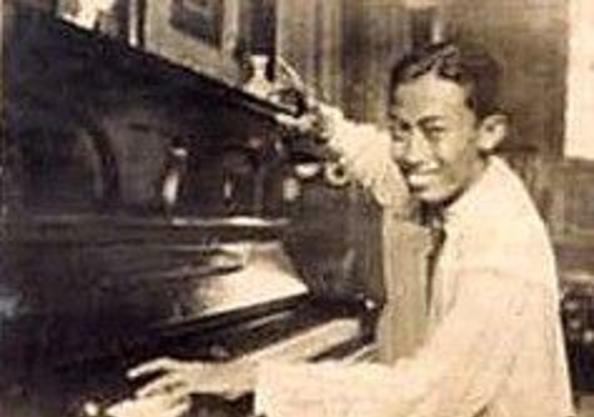Ismail Marzuki
 Marzuki studied at an elementary school for Native Indonesians, the Hollandsch-Inlandsche School Idenburg in Menteng; he later attended the Dutch-language middle school Meer Uitgebreid Lager Onderwijs on Menjangan Street in Jakarta. He became fluent in Indonesian, English, and Dutch. He also studied religion at Unwanul Wustha Madrasah. However, he didn't study music formally, instead learning by himself.
Marzuki studied at an elementary school for Native Indonesians, the Hollandsch-Inlandsche School Idenburg in Menteng; he later attended the Dutch-language middle school Meer Uitgebreid Lager Onderwijs on Menjangan Street in Jakarta. He became fluent in Indonesian, English, and Dutch. He also studied religion at Unwanul Wustha Madrasah. However, he didn't study music formally, instead learning by himself.In 1931, Marzuki wrote his 1st song, "O Sarinah", which was about a suffering people. During his career he wrote between 202 and 204 songs. Among his most famous compositions are "Rayuan Pulau Kelapa", "Gugur Bunga di Taman Bakti" (1945, The Fallen Flower in Bakti Garden), and "Selendang Sutera" (1946, A Coil of Silk).
 Marzuki started his music career by joining the Lief Java orchestra, under the direction of Hugo Dumas. In 1934 he became a broadcaster with Nederlandsch-Indische Radio Omroep Maatschappij, the national radio station of the Dutch East Indies, and afterwards led the Jakarta Studio Orchestra, the Bandung Studio Orchestra, and later the Hoso Kanri Kyoku orchestra during Japanese occupation of Indonesia.
Marzuki started his music career by joining the Lief Java orchestra, under the direction of Hugo Dumas. In 1934 he became a broadcaster with Nederlandsch-Indische Radio Omroep Maatschappij, the national radio station of the Dutch East Indies, and afterwards led the Jakarta Studio Orchestra, the Bandung Studio Orchestra, and later the Hoso Kanri Kyoku orchestra during Japanese occupation of Indonesia.In 1957 Marzuki wrote his last song, "Inikah Bahagia". He died at 14:00 on 25 May 1958 in his house in Tanah Abang, Jakarta. He is buried in Karet Bivak Cemetery.
Marzuki's anthems are full of patriotism and love for Indonesia, with a spirit of unity and harmony. They are easy to remember, with simple lyrics and melodies. The scales are generally mid-range, making the songs easier to sing.
Marzuki married Eulis Zuraidah, a Sundanese keroncong singer and orchestra leader from Bandung, in 1931. His wife has been considered as the inspiration of his Sundanese language song "Panon Hideung". Later it was known that "Panon Hideung" was Marzuki's Sundanese adaptation of Russian song Ochi Chernye.
Marzuki enjoyed collecting musical instruments. His collection included guitars, mandolins, flutes, clarinets, saxophones, accordions, and a piano.
He was known for being fiercely nationalistic, once selling gado-gado with his wife instead of cooperating with the Dutch-allied Nederlandsch Indix Civil Administratie during the Indonesian National Revolution. However, he also had a romantic side, writing songs like "Kalau Anggrek Berbunga", "Jauh di Mata Di Hati Jangan" (1947, Far from the Eyes (But Not the Heart) and "Siasat Asmara" (1948, Love's Tactics).
Marzuki has been described as "having good instincts for music", as well as a "genius" and "legendary".
A large number of Marzuki's songs have been rerecorded and released in different genres, including pop music and keroncong, such as"Kr. Pasar Gambir dan Stambul Anak Jampang" which was covered by Chrisye on the album Dekade with arrangement by Erwin Gutawa. Several of his songs, including "Gugur Bunga", "Melati di Tapal Batas", "Selendang Sutra", "Pahlawan Muda", "Rayuan Pulau Kelapa", and "Waktu Malam", are considered compulsory and taught in schools.
On 17 August 1961 Marzuki received the 1st Wijaya Kusuma award from President Suharto. He was honoured posthumously in 1968 with the opening of Taman Ismail Marzuki, a cultural centre and park in central Jakarta. He was recognized as a National Hero of Indonesia in November 2004 by declaration of President Susilo Bambang Yudhoyono.
Related Sites for Ismail Marzuki
- Ismail Marzuki « Buka Mata, Buka Hati, Buka Telinga read Ismail Marzuki
- ismail marzuki profiles | LinkedIn read Ismail Marzuki
- Ismail Marzuki | Facebook read Ismail Marzuki

No comments:
Post a Comment